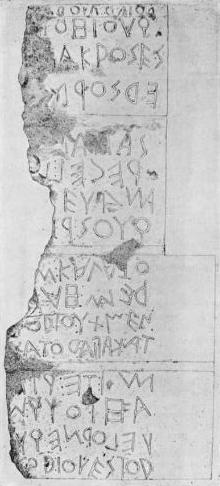
Back Boestrofedon Afrikaans Bustrophedon ALS Bustrofedon Azerbaijani Бустрафедон Byelorussian Бустрофедон Bulgarian বুস্ট্রফেডন Bengali/Bangla Bustrofedon Catalan Bustrofédon Czech Bustrofedon Danish Bustrophedon German

Boustrophedon (/ˌbuːstrəˈfiːdən/[1]) is a style of writing in which alternate lines of writing are reversed, with letters also written in reverse, mirror-style. This is in contrast to modern European languages, where lines always begin on the same side, usually the left.
The original term comes from Ancient Greek: βουστροφηδόν, boustrophēdón, a composite of βοῦς, bous, "ox"; στροφή, strophḗ, "turn"; and the adverbial suffix -δόν, -dón, "like, in the manner of" – that is, "like the ox turns [while plowing]".[2] It is mostly seen in ancient manuscripts and other inscriptions. It was a common way of writing on stone in ancient Greece,[3] becoming less and less popular throughout the Hellenistic period. Many ancient scripts, such as Etruscan, Safaitic, and Sabaean, were frequently or even typically written boustrophedon.

- ^ Harper, Douglas. "boustrophedon". Online Etymology Dictionary.
- ^ βοῦς, στροφή, βουστροφηδόν. Liddell, Henry George; Scott, Robert; A Greek–English Lexicon at the Perseus Project
- ^ Threatte, Leslie (1980). The Grammar of Attic Inscriptions. Vol. I Phonology. W. de Gruyter. pp. 54–55. ISBN 3-11-007344-7.